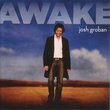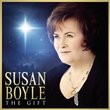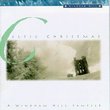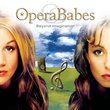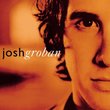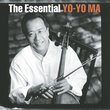| All Artists: Aaron Copland, Michael Tilson Thomas, San Francisco Symphony Orchestra, Garrick Ohlsson Title: Copland the Modernist Members Wishing: 1 Total Copies: 0 Label: RCA Release Date: 10/15/1996 Genre: Classical Styles: Opera & Classical Vocal, Forms & Genres, Concertos, Historical Periods, Modern, 20th, & 21st Century, Instruments, Keyboard, Symphonies Number of Discs: 1 SwapaCD Credits: 1 UPC: 090266854127 |
Search - Aaron Copland, Michael Tilson Thomas, San Francisco Symphony Orchestra :: Copland the Modernist
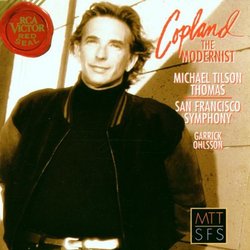 | Aaron Copland, Michael Tilson Thomas, San Francisco Symphony Orchestra Copland the Modernist Genre: Classical
The material covered on Copland the Modernist offers an important--and highly enjoyable--counterweight to the icon of folksy Americana that the composer is usually made out to be. And though such works as Appalachian Spr... more » |
Larger Image |
CD DetailsSynopsis
Amazon.com essential recording The material covered on Copland the Modernist offers an important--and highly enjoyable--counterweight to the icon of folksy Americana that the composer is usually made out to be. And though such works as Appalachian Spring and Rodeo have kept Copland high on the list of the 20th century's most popular composers, his achievement extends well beyond the familiar beauty of those musical landscapes. Michael Tilson Thomas, who has evolved into arguably the finest American conductor of his generation, has a special affinity for American maverick composers, and the selections here represent Copland as a probing artist who made his own impression straddling the popular-classical divide. In fact, Copland's later experiments in serialism were simply a natural development of his restless curiosity, of which these early assimilations of jazz into a symphonic idiom are excellent examples. Tilson Thomas manages at the same time to convey the heady inspiration from European models and the sense of embarking on a brave new world that went into the Short Symphony and Symphonic Ode (composed for the Boston Symphony). This is spectacular, spiky, incisive playing by a great American orchestra of a great American composer. --Thomas May Similarly Requested CDs
|
CD ReviewsMy favorite Copland disc Homiski | 08/17/2000 (5 out of 5 stars) "What separates this disc from hundred other Copland discs are the incredible performances of the San Francisco Symphony w/ MTT and the specific programming combination of pieces compiled here. The disc has the rarely heard "Symphonic Ode" as well as tour d'force 2nd Symphony and the "Orchestral Variations." The placement of these latter two pieces is particularly rewarding. Any follower of Copland must have this disc in their CD collection. Anyone who has heard his "Fanfare for the Common Man" or "Appalachian Spring" ballet will be challenged. The Orchestral Variations are an orchestration of his "Piano Variations" (from 1930/1931, I think). The Piano version became 'in-famous' at Tanglewood when a young pianist named Leonard Bernstein used to play them at receptions and concerts. Today they don't have the harsh edge or bite that they might have had then, but listeners used to "Fanfare for the common man" might be a little fidgety.The real meaty tour d'force is his 2nd symphony. MTT gets an amazing sound from the SFS on this recording. The 2nd symphony wasn't performed for decades after Copland first wrote it. Koussevitsky said it was 'too difficult' for the orchestra. Disconsoled and uncertain about future performances Copland made a sextet version which also ROCKS (see Boston Symphony Orchestra Chamber Player recording on Nonesuch/Elektra). Finally at the 21st century orchestras CAN indeed play it and play it with such conviction. The challenging cross meter and multiple beat patterns pose no problem for MTT and the SFS.If you want to expand your Copland horizon, get this disc!" ...lesser known works David Brooks | Spruce Grove, AB Canada | 03/01/2004 (5 out of 5 stars) "For anyone wanting to go beyond the popular works of "Fanfare For The Common Man", "Appalachian Spring", "Rodeo Suites" and "Billy The Kid"...this disc is a good introduction to neglected works that had a bit of a shaky history. "The Short Symphony" was viewed as being to difficult to perform and ended up resurfacing in small scale works. The piece is represented by three movements fast-slow-fast that are played without a pause in the music with the extraordinary beauty of the slow movement. "The Concerto For Piano And Orchestra" makes full use of jazz material with the piano conversing with the rest of the instruments. Michael Tilson Thomas has a good feel for Copland, as he does for any other American composer and the performance of the San Francisco Symphony is brisk and clear. This disc is most certainly a welcomed addition to any Copland collection, although there are no signs of any patriotic hymns or overtures that you can expect elsewhere." Copland "the modernist"? Well - relatively to Copland the "p Discophage | France | 06/23/2009 (4 out of 5 stars) "It would be comfortable to think of Copland as the early modernist turned populist (he would have been neither the first nor the last), but the picture isn't so simple. When , in view of the lack of success of his early compositions, he turned to a more populist style, heralded in 1936 by El Salon Mexico, Copland never abandoned his "modernist" manner, and the two subsequently coexisted.
I am not very interested in Copland the populist and composer of "Western" music, but I much admire Copland the "modernist". I consider the Piano Sonata, Piano Fantasy and Piano Variations to belong to the great masterpieces of 20th Century piano literature. In fact, calling the composer of those and other "serious" compositions a "modernist" is a bit exaggerated. That Copland was considered such in the 1930s says a lot about the state of cultural backwardness of audiences and critics then. Heard today, Copland's "serious" compositions (or "severe" as he himself characterized them) are rarely difficult music. They are serious, yes, but also alternately grandiose and granitic, intensely lyrical, and sweepingly dynamic. Yes, there are dissonances and crashing chords - always at the service of a great dramatic impact. Elements of the musical language that Copland uses in his more popular pieces can easily be recognized even in earlier ones. The difference between the modernist and the populist isn't a case of schizophrenia. In that respect, it takes really a wide stretch of the imagination tho attribute the Piano Concerto to the "modernist" - or even to the "serious" Copland. It is a short piece (17 minutes here), in two movements, and the second is Copland out-jazzing Gershwin. It may have been viewed as modernist back when it was premiered in 1927 - granted, it is more unruly, rambunctious and angular than anything Gershwin ever wrote, more like "Bartok meets West-Side Story" (I hear striking echoes of Bartok's 2nd Piano Concerto) - but heard today it is as "populist" as it will get. The first movement, alternating grandiose and sweepingly epic fanfares and more pastoral moments (sunset on the prairie after a hard day's work), announces Copland's later style. The Orchestral Variations are the orchestration, made in 1957 on a commission by the Louisville Orchestra, of the early Piano Variations from 1930. The music is maybe not "modernist" (not compared to Schoenberg or Varèse, not to mention whoever was modern in 1957) but certainly "severe", and it is a great orchestral piece, entirely convincing and self-sufficient in its orchestral guise. All is clearly announced in the powerful, stark and overbearing statement of its theme - a musical evocation perhaps of the awe and terror inspired to the mortal soul when the Gates of Heaven open for Judgment. It is followed by twenty (short) variations and a coda (not individually cued), each running so smoothly into the next that the seams can hardly be heard. It is imposing and "eloquent" - a character indication that often comes under Copland's pen. Incredible how much the "Short Symphony" from 1933 sounds like Stravinsky - but the Stravinsky of The Rakes Progress (1951) or even Agon (1957). It is sprightly, spirited, almost abstract in its staccato jauntiness, while its second movement develops to great lyrical intensity in a way that also evokes Honegger. After its world premiere in Mexico City in 1934 under Carlos Chavez, it didn't get a US premiere until 1944, as Stokowski and Koussevitzky, while admiring it, considered it too complex rythmically for their respective orchestra (no less than Philadelphia and Boston) to master it in the alloted rehearsal time. It is is a marvelous composition. And so is the Symphonic Ode. Its first version, writtten for a Mahler-sized orchestra, was completed in 1929 and it got its first performance in 1932 under Koussevitzky, but Copland withdrew it and re-orchestrated it for smaller forces in 1955. It exudes tremendous rhythmic energy, and like the Short Sypmphony it is filled with a spirit of dance, while its slow, middle section (it has five, playing without break) develops to great lyrical intensity and stark eloquence. It is the most dissonant of the compositions featured here. MTT and SFSO deliver good to outstanding interpretations, that come against the strong competition represented by the composer's own recordings - in the Piano Concerto both as conductor, in 1961 with Earl Wild (Copland, Menotti: Piano Concertos, Copland: Piano Concerto And Orchestra/Menotti: Concerto In F For Piano And Orchestra), and pianist, in 1964 with Bernstein (The Copland Collection: Early Orchestral Works, 1922-1935). Ohlsson is more subtle of touch than Copland, but Copland's biting accents and cruder sonics, as well as Wild's greater muscularity and bigger tone, are more appropriate in the Jazzy 2nd movement. But overall all three conductors and orchestras have the required verve, dynamism and rambuctiousness (see my reviews of the two other recordings for more details). In the Orchestral Variations comparisons with the composer himself (The Copland Collection: Orchestral Works, 1948-1971), Bernstein live in 1958 (New York Philharmonic - An American Celebration vol. 2) and Robert Whitney in the 1958 premiere recording with the Louisville Orchestra (Variations) - the two latter in mono - show that the piece can be conducted with marginally more tautness (Copland), urgency and violence (Bernstein), rawness and uncompromissing starkness and bite than MTT. Still MTT's is a fine reading, imposing in the theme and first variations, suitably urgent in the final ones (14 to 20), and the Sanfranciscans play with peerless ensemble. In the Symphony and the Ode, when there is an interpretive difference with Copland (more in the Ode than the Symphony), it is MTT's favor: in the Symphony, he is slightly more driven, muscular and snappy in the finale. Likewise in the Ode TT is swifter and more urgent than Copland's more solemn approach. There are spots where Copland's LSO in 1965 and 67 seems to struggle with the notes, the Sanfranciscan have them in their stride. But where Copland's recordings have a surprising edge is in the area of sonics: they have much more presence, vividness and instrumental color than MTT's digital recording (I was bothered more in the PC and Variations), making them, still today, a first choice, and TT a welcome complement. " |

 Track Listings (7) - Disc #1
Track Listings (7) - Disc #1